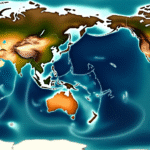Introduction
Without documents, lacking formal opportunities, and with the distant hope of reaching the United States, Venezuelan migrants like José, a 32-year-old man, have been forced to integrate into Mexico’s informal economy just to survive.
José’s Story
Leaving Venezuela six years ago, José first lived in Peru before attempting to reach the United States. However, stricter U.S. immigration policies halted his journey, leaving him in Mexico since October. He now works as a onion peeler at La Merced market in Mexico City, sharing rented accommodation with other Venezuelan and Ecuadorian migrants.
José attempted to cross the border but failed, stating, “I didn’t make it.” Despite Mexican authorities reactivating procedures for regularizing migrants’ stay, José has chosen not to pursue this option. His plan is to save enough money to return to Venezuela, acknowledging his precarious presence in Mexico.
Venezuelan Migrants in Mexico City
Venezuelan migrants facing eviction from a camp in Mexico City’s Vallejo neighborhood expressed their intention to build stable lives in Mexico, despite hardships. Interviewed anonymously for safety reasons, they shared their work experiences, personal projects, and firm stance against returning to their home countries.
Many have integrated into the Mexican labor market, primarily in construction. Some have even started small businesses. “We’ve achieved labor stability, found good clients, and are trying to establish our own construction company,” said one interviewee. They believe Mexico offers better opportunities than other countries they passed through on their migration route.
Initially aiming for the U.S., their plans changed due to CBP One program suspension and migration difficulties. Now, they view Mexico as a real residence and development option.
“Here, there are more opportunities, and we’ve found support from citizens and religious organizations. We want to legalize our status and grow here,” they stated.
Migration Statistics
In the past six years, Mexico has seen a significant increase in events of people presented to migration authorities. Between 2018 and 2024, the number rose from 131,445 to 1,234,698—an 839% increase.
By 2024, Venezuelans (361,203) accounted for the most cases, followed by Ecuadorians (118,495) and Hondurans (90,097). The exact number of irregular migrants in Mexico is difficult to determine due to overlapping events.
During the same period, the number of foreigners returned by Mexican migration authorities decreased significantly from 115,686 to 20,834—an 82% reduction.
Eviction Deadline in Gustavo A. Madero
On January 26, Mexico City authorities resumed operations to evict and relocate migrants from unauthorized camps in the Vallejo neighborhood, Gustavo A. Madero aldermancy, where around 400 people, including 100 children, reside.
Authorities notified migrants, mainly from Venezuela, Ecuador, Colombia, Honduras, and Nicaragua, to move to the Casa de Asistencia a la Movilidad Humana Vasco de Quiroga shelter in Tepito. The settlement must be vacated by today, according to authorities.
Venezuela’s ambassador to Mexico, Stella Lugo, visited the camp to offer repatriation flights to her country’s nationals. She reported, “The Mexican and Maduro governments have agreed on a plan to return our migrants. In two months, we’ve repatriated 1,200 people.”
Temístocles Villanueva, head of the Mexico City Government’s Mobility Human Coordination, assured that minors would receive school transportation to avoid missing the school year. The Vasco de Quiroga shelter can accommodate up to 500 people and currently houses around 100.
Key Questions and Answers
- Who are the migrants mentioned? The migrants discussed are primarily Venezuelans, with some Ecuadorians and others from neighboring countries.
- What challenges do they face? They struggle with integration into the formal economy, lack of documentation, and changing migration policies.
- What are their plans? Some aim to return to their home countries, while others seek stability in Mexico.
- What are the migration statistics? Between 2018 and 2024, events of people presented to migration authorities in Mexico increased by 839%, with Venezuelans being the largest group.
- What is happening with evictions in Mexico City? Authorities are evicting migrants from unauthorized camps, relocating them to shelters and offering repatriation flights.






